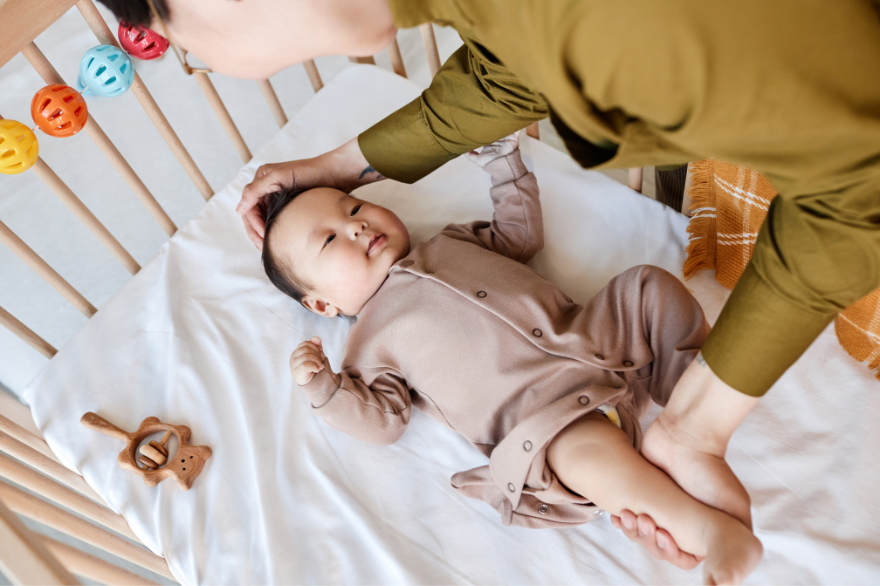Hi there! As a new parent, one of the things that you might be struggling with is getting your baby to sleep. It’s a common struggle, but it’s essential to your baby’s health and development.
In this blog post, we’ll be discussing why training your baby to sleep in a bassinet is important and the ideal time to start the training process.
Why training baby to sleep in a bassinet is important
Sleep training is a method designed to help babies learn how to self-soothe and fall asleep without outside intervention. One of the first steps in sleep training is creating a safe sleep environment for your baby. Bassinets are an excellent choice because they provide a secure, cozy, and comfortable space for your baby to sleep.
Additionally, sleeping in a bassinet reduces the risk of Sudden Infant Death Syndrome (SIDS). Babies who sleep in a bassinet are less likely to get trapped between pillows, blankets, or the side of the bed, which can be fatal. Therefore, training your baby to sleep in a bassinet is essential for both their safety and development.
The ideal time to start training baby
The ideal time to start sleep training your baby varies from child to child. Most babies can begin sleeping in a bassinet from birth. However, it’s essential to note that all babies develop at their own pace, and some might need more time to adjust than others.
It’s recommended that parents start sleep training when their baby is around three to four months old. By this time, babies have developed a consistent sleep-wake cycle, which makes it easier for them to learn good sleep habits.
In conclusion, training your baby to sleep in a bassinet is an essential aspect of their health and development. It’s essential to find the right time for your child and to create a safe sleep environment to ensure they get the sleep they need.

Preparation
Hey there! As a new parent, I understand how overwhelming it can be to prepare for your baby’s arrival. One of the things you’ll need to consider is where your baby will sleep. In this blog post, we’ll discuss the necessary preparations for training your baby to sleep in a bassinet.
Selecting the right bassinet
When selecting a bassinet, make sure to look for one that is safe and comfortable for your baby. Choose a sturdy bassinet, that has a firm mattress and breathable sides. Also, opt for a bassinet that comes with a fitted sheet made from soft and gentle fabric to help your baby sleep better without irritation.
Setting up the bassinet for baby’s comfort
Before placing your baby in the bassinet, ensure that it is set up correctly. Consider placing the bassinet near your bed for easy access at nighttime. The temperature in the room should also be comfortable for your baby, which means not too hot or too cold. Opt for light blankets that won’t be too warm for the baby.
In conclusion, preparing for your baby’s sleep training in a bassinet is essential. Make sure you choose the right one and set it up for your baby’s comfort. By doing so, your baby can learn to self-soothe and fall asleep efficiently in their safe and secure space!
Preparation for Training Your Baby to Sleep in a Bassinet
Hello, fellow parents! As a new parent myself, I know how challenging it can be to prepare for your little one’s arrival. One crucial aspect to consider is where your baby will sleep, and in this blog post, I’ll share some tips to prepare for training your baby to sleep in a bassinet.
Selecting the Right Bassinet
When choosing a bassinet, always prioritize your baby’s safety and comfort. Select a sturdy one with a firm mattress and breathable sides. Make sure it comes with a fitted sheet made from soft and gentle fabric. This can help your baby sleep soundly without any irritation.
Setting up the Bassinet for Your Baby’s Comfort
The bassinet should be placed close to your bed, so it’s easy to access your baby during nighttime feedings. Ensure that the room temperature is comfortable, not too hot or cold. You can use light blankets that won’t be too warm for your baby’s delicate skin.
Establishing a Bedtime Routine
Creating a Consistent Bedtime Routine
Establishing a regular sleep schedule is beneficial for both you and your baby. It’s essential to create a consistent bedtime routine that includes relaxing activities like a warm bath or gentle massage. This will help signal to your baby that it’s time to sleep.
Importance of Sticking to a Routine
Sticking to a routine can help your baby feel safe and secure, which can significantly improve sleep quality. Try to be consistent with the time your baby goes to bed and wakes up in the morning. Over time, your baby will learn the routine and start falling asleep faster and staying asleep for more extended periods.
In conclusion, preparing for your baby’s sleep training is crucial, but it doesn’t have to be a daunting task. By selecting the right bassinet and establishing a consistent bedtime routine, you can help your baby sleep better and feel more relaxed.

Preparation for Training Your Baby to Sleep in a Bassinet
Hey there fellow parents! As a new parent myself, I understand how overwhelming it can be to prepare for your little one’s arrival. One of the most crucial things to consider is where your baby will sleep. In this post, I’ll share some tips on how to prepare for training your baby to sleep in a bassinet.
Selecting the Right Bassinet
When choosing a bassinet, prioritize your baby’s safety and comfort. A sturdy one with a firm mattress and breathable sides is an excellent choice. Make sure it comes with a fitted sheet made of soft and gentle fabric for your baby’s comfort.
Setting up the Bassinet for Your Baby’s Comfort
Place the bassinet close to your bed, so you can quickly tend to your baby during nighttime feedings. Ensure the room temperature is comfortable and not too hot or cold. You can use light blankets that won’t be too warm for your baby’s delicate skin.
Establishing a Bedtime Routine
Creating a Consistent Bedtime Routine
Establishing a regular sleep schedule is essential for both you and your baby. Create a consistent bedtime routine that includes relaxing activities such as a warm bath or gentle massage. This will help signal to your baby that it’s time to sleep.
Importance of Sticking to a Routine
Sticking to a routine can help your baby feel safe and secure, which can significantly improve sleep quality. Try to be consistent with the time your baby goes to bed and wakes up in the morning. Over time, your baby will learn the routine and start falling asleep faster and sleeping for more extended periods.
Consistent Sleep Environment
Creating a conducive environment for the baby to sleep
Creating a conducive sleep environment is essential to help your baby sleep soundly. Use soft and soothing colors for the nursery, like pastels, and avoid stimulating objects.
Managing light and temperature in the nursery
Make sure the room is dark enough to encourage sleep, especially during naptime. Install blackout curtains or use a white noise machine if necessary. Manage the temperature, so it’s not too hot or cold, and use a good quality humidifier to keep the air comfortable.
Remember that preparing for your baby’s sleep training can be easy with a little preparation and patience. Try one tip at a time to see what works best for your little one.
Preparation for Training Your Baby to Sleep in a Bassinet
Hi, fellow parents! As a new parent myself, I understand how overwhelming it can be to prepare for your little one’s arrival. One of the most crucial things to consider is where your baby will sleep. Here are some tips on how to prepare for training your baby to sleep in a bassinet:
Selecting the Right Bassinet
When choosing a bassinet, you should prioritize your baby’s safety and comfort. Choose a sturdy one with a firm mattress and breathable sides. Make sure it comes with a fitted sheet made of soft and gentle fabric for your baby’s comfort.
Setting up the Bassinet for Your Baby’s Comfort
It’s important to place the bassinet close to your bed, so you can quickly tend to your baby during nighttime feedings. Ensure the room temperature is comfortable and not too hot or cold. Use light blankets that won’t be too warm for your baby’s delicate skin.
Sleep Training Techniques
Gradual Retreat Method
In this technique, you gradually move away from your baby as they fall asleep until they can sleep independently. Start by sitting next to the bassinet as they fall asleep, then gradually move away from the bassinet night after night until you’re out of sight but within earshot.
Fading Method
This involves gradually reducing your level of intervention as your baby falls asleep. You can start by patting their tummy, humming, or singing a lullaby as they drift off to sleep. Over time, you can reduce the amount of time you spend doing these things until you can leave the room without waking them.
Consistent Sleep Environment
Creating a conducive environment for the baby to sleep
A conducive sleep environment is essential to help your baby sleep soundly. Use soft and soothing colors for the nursery, like pastels, and avoid stimulating objects.
Managing light and temperature in the nursery
Make sure the room is dark enough to encourage sleep, especially during naptime. Install blackout curtains or use a white noise machine if necessary. Manage the temperature, so it’s not too hot or cold, and use a good quality humidifier to keep the air comfortable.
Remember that preparing for your baby’s sleep training can be easy with a little preparation and patience. Try one technique at a time to see what works best for your little one.
Preparing Your Baby to Sleep in a Bassinet
Hey there, fellow parents! As a new parent myself, I know how crucial it is to prepare for our baby’s arrival. One of the most important decisions we have to make is where our baby will sleep. Here are some tips on preparing your baby to sleep in a bassinet:
Selecting the Right Bassinet
First, choose a bassinet that is safe and comfortable for your baby. Look for one with a firm mattress and breathable sides. Pick a fitted sheet made from soft, gentle fabric for your baby’s comfort.
Setting up the Bassinet for Your Baby’s Comfort
Position your bassinet close to your bed, so you can quickly tend to your baby during nighttime feedings. Ensure the room temperature is comfortable and not too hot or cold. Use light blankets that won’t be too warm for your baby’s delicate skin.
Sleep Training Techniques
Gradual Retreat Method
With the gradual retreat method, you move away from your baby gradually as they fall asleep until they learn to sleep independently. Start by sitting next to the bassinet as they fall asleep, then gradually move away from the bassinet night after night until you’re out of sight but still within earshot.
Fading Method
The fading method involves reducing your intervention as your baby falls asleep gradually. You can start by patting their tummy, humming, or singing a lullaby as they drift off to sleep. Over time, you can decrease the amount of time you spend doing these things until you can leave the room without waking them.
Consistent Sleep Environment
Creating a Conducive Environment for Baby to Sleep
A conducive sleep environment is essential to help your baby sleep soundly. Use soft and soothing colors for the nursery, like pastels, and avoid stimulating objects.
Managing Light and Temperature in the Nursery
Make sure the room is dark enough to encourage sleep, especially during naptime. Install blackout curtains or use a white noise machine if necessary. Manage the temperature, so it’s not too hot or cold, and use a good quality humidifier to keep the air comfortable.
Gradual Extension Method
Gradual Extension Method Explained
The gradual extension method involves gradually extending the time between visits to your baby’s room at night. This method helps your baby learn to fall asleep without needing you to soothe them to sleep. Start by waiting a few minutes before checking on them, then gradually increase the time each night until your baby can sleep for longer stretches without needing you.
Benefits of the Gradual Extension Method
The gradual extension method is a gentle way to teach your baby to self-soothe and sleep better through the night. This method can also help reduce nighttime feedings, helping both you and your baby get more restful sleep.
Remember, preparing for your baby’s sleep training takes patience and preparation. Try one technique at a time to see what works best for your little one. Good luck!
Preparing My Baby to Sleep in a Bassinet
Hi there, fellow parents! As a new mom myself, I understand the importance of preparing for my baby’s arrival, including selecting where my baby will sleep. Here are some tips I’ve learned on preparing my baby to sleep in a bassinet:
Selecting the Right Bassinet
I chose a bassinet that’s safe and comfortable for my baby, with a firm mattress and breathable sides. I made sure to pick fitted sheets made from soft, gentle fabric for my baby’s comfort.
Setting up the Bassinet for My Baby’s Comfort
I positioned the bassinet close to my bed, so I could easily attend to my baby during nighttime feedings. I made sure the room temperature was comfortable and chose light blankets that wouldn’t be too warm for my baby.

Sleep Training Techniques
Teaching My Baby to Self-Soothe
One of the most important aspects of sleep training is teaching my baby to self-soothe. This skill allows my baby to fall back asleep on their own without needing me to intervene.
Techniques to Improve Self-Soothing Skills
I tried gradual retreat and fading methods to help my baby learn to sleep independently. Over time, I reduced the amount of time I spent soothing or checking on my baby until they could sleep for longer stretches without needing me.
Consistent Sleep Environment
Creating a Conducive Environment for My Baby to Sleep
A soothing and consistent sleep environment is crucial for my baby to sleep soundly. I chose soft and calming colors for the nursery and avoided stimulating objects.
Managing Light and Temperature in the Nursery
I made sure the room was dark enough to encourage sleep, especially during naptime, by using blackout curtains or a white noise machine. I managed the temperature, so it was comfortable for my baby and used a humidifier to keep the air quality good.
The Importance of Self-Soothing Skills
Self-soothing skills are essential for my baby’s growth and development. This skill helps them sleep independently and reduces their dependence on me to soothe them to sleep during every waking period.
Remember, preparing for sleep training takes time and patience. Trying one technique at a time is essential to see what works best for my little one. Good luck!
Troubleshooting Sleep Problems
Hey fellow parents! As a new mom, I understand how difficult it can be when your little one isn’t sleeping well. Here are some tips I’ve learned on troubleshooting sleep problems:
Common sleep problems in babies
Some common sleep issues that babies experience are difficulty falling asleep, frequent night wakings, and short naps during the day.
Solutions to common sleep issues
To help my baby fall asleep more easily, I established a consistent bedtime routine and made sure to create a calm and dimly lit environment. To reduce frequent night wakings, I made sure my baby’s feedings and diaper changes were done before bedtime and tried to avoid stimulation during nighttime feedings. For short naps during the day, I created a naptime routine and used white noise to help my baby fall asleep and stay asleep.
Remember, every baby is different, and it can take some trial and error to find what works for your little one. Don’t be afraid to ask for help or advice from your pediatrician or other parents in your support network. Together, we can help our babies get the restful sleep they need for their growth and development!
Troubleshooting Sleep Problems
Hi there fellow parents! As a new mom myself, I completely understand how challenging it can be when your little one doesn’t sleep well. That’s why I’ve put together some tips and tricks that I have learned to help troubleshoot sleep problems and ensure a good night’s rest for both baby and parent.
Common Sleep Problems in Babies
Some common sleep issues that babies experience include difficulty falling asleep, frequent night wakings, and short naps during the day. These issues can make it tough for both baby and parent to get the necessary rest that they need.
Solutions to Common Sleep Issues
I’ve discovered several ways to help my baby fall asleep more easily. Establishing a consistent bedtime routine and creating a calm and dimly lit environment have helped immensely. To reduce frequent night wakings, I made sure to feed and change my little ones before bedtime and tried to avoid anything that would stimulate them during nighttime feedings. For short naps during the day, creating a naptime routine and using white noise have been game changers.
Summary of Key Takeaways
- Establish a consistent bedtime routine
- Create a calm and dimly lit environment
- Feed and change the baby before bedtime
- Avoid stimulation during nighttime feedings
- Create a naptime routine
- Use white noise to help the baby fall asleep and stay asleep
Final Thoughts
Remember, every baby is unique and what works for one, may not work for another. Don’t hesitate to ask for help or advice from your pediatrician or other parents in your support network. With these tips and a little patience, your baby can eventually develop healthy sleep habits that work for both of you. Good luck!


